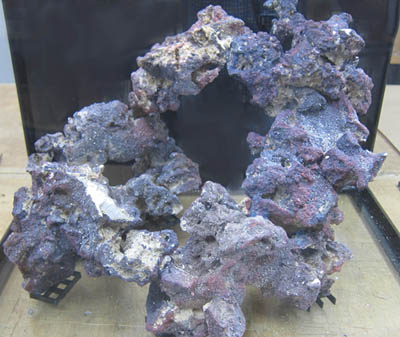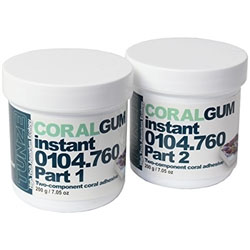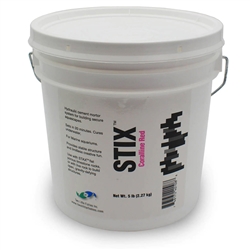Jaronís Top 10 Reef Aquascaping Tips
 1. If Possible Aquascape Dry
It is a lot easier to glue rocks together to be sure that the rocks are in the exact right position if you can position the rocks in the tank while it is empty. In some cases, you will be moving an established tank that has coral on the rock already, or you may have purchased expensive live rock that will need to stay wet. In the majority of cases, you should be able to aquascape your tank while the tank is dry. Even if you purchase live rock, only the most expensive live rock is shipped submerged in water. Most live rock is simply wrapped in wet newspaper or towels. In this case, you can keep a spray bottle with saltwater on hand to keep the rock moist but donít feel that you need to immediately submerge the live rock. 1. If Possible Aquascape Dry
It is a lot easier to glue rocks together to be sure that the rocks are in the exact right position if you can position the rocks in the tank while it is empty. In some cases, you will be moving an established tank that has coral on the rock already, or you may have purchased expensive live rock that will need to stay wet. In the majority of cases, you should be able to aquascape your tank while the tank is dry. Even if you purchase live rock, only the most expensive live rock is shipped submerged in water. Most live rock is simply wrapped in wet newspaper or towels. In this case, you can keep a spray bottle with saltwater on hand to keep the rock moist but donít feel that you need to immediately submerge the live rock.
-CaribSea LifeRock Shapes & LifeRock Arches
2. Keep The Rock Off Of The Ground
As a practical consideration, do your best to minimize the amount of rock touching the bottom glass. Rock doesnít float so you will inevitably have to touch it in some places but having the rock elevated off the sand will allow water flow below the rock work which will help to stop detritus from accumulating and it will create natural caves for fish to hide in.
3. Add Sand Last
Many people think that because sand is on the bottom of the tank it should be added first. In my experience, your rock structure is much more stable if you add the rock directly on top of the solid glass and then pour the sand around the rock to help anchor it in place. If the rock is sitting on sand rather than on the glass then sometimes the sand underneath the rock can shift and cause a mini avalanche in your tank.
4. A 3-Legged Stool Is The Most Stable
If you are following tip #2 then you are trying to minimize the amount of rock touching the bottom of the tank. Because the rocks are irregularly shaped it is almost impossible to make a stable platform unless you have three points touching the bottom glass. If you are relying on two small rocks to support a larger rock then the structure will tend to rock back and forth. If you are trying to make a flat plane with four or more rocks, then it is very difficult to get all of the points to rest perfectly flat. Try using a tripod structure to lift bigger rocks off the ground. This is the easiest way to get large rocks elevated off the ground and keep the structure stable.
5. Know Your Different Adhesives
A rookie mistake when aquascaping your first tank is not gluing the rocks together. Your rockwork might feel stable initially, but once you have large digging and burrowing fish and snails and urchins that try to shove themselves into every nook and cranny there is bound to be a rockslide that shatters one of your favorite coral colonies. It is best to keep your rocks held together with some kind of adhesive. There are three types of adhesives you can use: glue, epoxy and cement.
- 1. Glue
.jpg) Glue is the most popular and most useful adhesive for aquarium applications. While any Cyanoacrylate ďSuperGlueĒ can be used, we recommend you purchase an aquarium-specific glue, such as the MarineAndReef.com Extra Thick Maxi Cure Glue. Aquarium glues will not contain any additives or preservatives that could be harmful to your aquarium inhabitants. Additionally, most general-purpose superglue is very runny, and as such it is hard to keep it in place and get it where you want. If you use the Glue Accelerator with the glue this will help the glue to harden extra quickly. While glue is a good adhesive it does have some limitations. It is very difficult to use wet. If you place a tube of glue underwater, then water will rush back into the bottle after you squeeze it ruining the rest of the tube. It is best to apply glue dry. If you quickly remove corals or live rock. apply the glue. and return them to the tank immediately, the glue can harden very quickly. Less than ten minutes in most cases. Glue is also much better at sticking together smaller objects rather than large rock structures and boulders. Glue is strong but not as strong as rock so large rock structures that are glued together tend to split apart at the glue seams because of the stress from the weight of the rocks over time. Glue is the most popular and most useful adhesive for aquarium applications. While any Cyanoacrylate ďSuperGlueĒ can be used, we recommend you purchase an aquarium-specific glue, such as the MarineAndReef.com Extra Thick Maxi Cure Glue. Aquarium glues will not contain any additives or preservatives that could be harmful to your aquarium inhabitants. Additionally, most general-purpose superglue is very runny, and as such it is hard to keep it in place and get it where you want. If you use the Glue Accelerator with the glue this will help the glue to harden extra quickly. While glue is a good adhesive it does have some limitations. It is very difficult to use wet. If you place a tube of glue underwater, then water will rush back into the bottle after you squeeze it ruining the rest of the tube. It is best to apply glue dry. If you quickly remove corals or live rock. apply the glue. and return them to the tank immediately, the glue can harden very quickly. Less than ten minutes in most cases. Glue is also much better at sticking together smaller objects rather than large rock structures and boulders. Glue is strong but not as strong as rock so large rock structures that are glued together tend to split apart at the glue seams because of the stress from the weight of the rocks over time.
For using glue when coral fragging, check out our Coral Fragging Overview.
- 2. Epoxy
 Epoxy is two separate putty layers designed to be mixed together. Once mixed the putty will harden into a rock-hard solid material after several hours. There are some advantages and disadvantages of epoxy. Firstly, epoxy is the best adhesive to use underwater. Once you have mixed the layers you can very easily manipulate the epoxy underwater to get it where you need it. Epoxy is also stronger than glue, making it better for attaching large rocks and corals. The downside to epoxy is that it isnít that sticky. It is best to think of epoxy like a clay that turns into a rock. If you are trying to attach two flat pieces of rock, the epoxy wonít stick to the surface of the rocks and the bond wonít work. Epoxy is best with bumpy, pointy, and irregularly shaped rocks. The epoxy can work into all of the nooks and crannies of the two rocks you are bonding together and then solidify to make a strong bond. Epoxy also takes pretty long to dry. Our favorite epoxy is Two Little Fishies AquaStick. It is affordable, hardens strong, and is a pleasant coraline algae color making the epoxy less noticeable. But it normally takes about six hours to completely harden. If you want something that hardens fast you can try Tunze Coral Gum Instant. This hardens very fast but is also quite expensive. Epoxy is two separate putty layers designed to be mixed together. Once mixed the putty will harden into a rock-hard solid material after several hours. There are some advantages and disadvantages of epoxy. Firstly, epoxy is the best adhesive to use underwater. Once you have mixed the layers you can very easily manipulate the epoxy underwater to get it where you need it. Epoxy is also stronger than glue, making it better for attaching large rocks and corals. The downside to epoxy is that it isnít that sticky. It is best to think of epoxy like a clay that turns into a rock. If you are trying to attach two flat pieces of rock, the epoxy wonít stick to the surface of the rocks and the bond wonít work. Epoxy is best with bumpy, pointy, and irregularly shaped rocks. The epoxy can work into all of the nooks and crannies of the two rocks you are bonding together and then solidify to make a strong bond. Epoxy also takes pretty long to dry. Our favorite epoxy is Two Little Fishies AquaStick. It is affordable, hardens strong, and is a pleasant coraline algae color making the epoxy less noticeable. But it normally takes about six hours to completely harden. If you want something that hardens fast you can try Tunze Coral Gum Instant. This hardens very fast but is also quite expensive.
- 3. Cement
 Cement leads to the sturdiest bonds between rocks. It is the best way to get a good solid rock structure, and it is what we recommend if you have the time and patience to deal with it. While manufacturers claim you can use cement underwater, we do not recommend it. Cement leads to the sturdiest bonds between rocks. It is the best way to get a good solid rock structure, and it is what we recommend if you have the time and patience to deal with it. While manufacturers claim you can use cement underwater, we do not recommend it.
To use a cement such as Two Little Fishies STIX. You will get a bucket with two components. You need to mix small amounts of the two components with some tap water to make a mortar, and then you can use the included spatula to apply the mortar to your rocks. The mortar will start hardening quickly but wonít completely harden until overnight. Once hardened the cement will make a very strong bond. This makes the cement ideal for creating large dynamic rock structures that donít want to fall apart. It is much more difficult to deal with than glue or epoxy. You will be continually mixing up small amounts and varying the amount of water to get a consistency that works for your application. The work can be worth it if you can create the aquascape of your dreams.
6. Leave Room to Work
Donít forget that you will need to clean your aquarium. Wiping the glass and vacuuming the substrate is a lot easier if the rock isnít right up against the glass. You also want to avoid tucking equipment underneath rocks. This can look good and be fine for a while but as soon as you need to clean or replace that piece of equipment you may find it nearly impossible to remove.
7. Remember Corals Grow
Donít forget that your coral will grow on top of the rocks. A common mistake is to add too much rock so that the tank looks good at first but once the corals have grown large the tank looks overly crowded. Make sure to leave open space for fish to swim in and corals to grow. The tank should look a bit empty when you start because you know that it will get filled in over time.
 8. Use the Rule of Thirds 8. Use the Rule of Thirds
If you are like me and donít have an intuitive design aesthetic, then the rule of thirds is one of the best principles to remember when creating your rockscape. The rule of thirds is a design principle where you draw imaginary lines dividing your tankís front viewing pane into thirds both horizontally and vertically. The result is an imaginary tic-tac-toe board. The rule of thirds states that where the lines intersect is where you should have your points of emphasis. Putting your most interesting corals or rock structures at these points rather than directly in the center of the tank will stop your eye from ignoring the whole tank and only focusing on that one coral.
9. Remember the Effect of Scale
One thing many people notice after they have set up their tank is the tank that feels very big when empty starts to feel much smaller once you fill it with rocks and corals. In general, incorporating smaller elements will make the tank feel bigger. Using smaller rocks and sand with a smaller grain will make the tank feel bigger by creating a size contrast. Using extra chunky gravel and large bolder-like rocks will make your tank feel very small. You can also make a tank feel larger by including smaller fish rather than larger ones.
10. A Hammer and Chisel Are Your Friends
You donít need to keep the rocks in the same shape they arrived in. Using a hammer and chisel to break down the rocks will help you create a more interesting shape. If you are trying to create a specific shape it is often easier to cement together smaller rock pieces than to try and find the perfectly shaped piece. The smaller pieces will also help to contribute to the sense of scale previously mentioned.
|





























.jpg)


 8. Use the Rule of Thirds
8. Use the Rule of Thirds